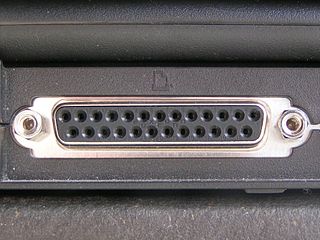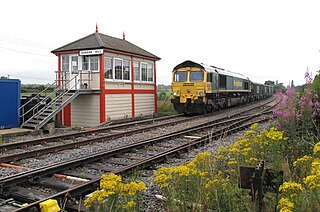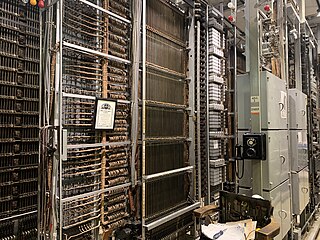Circuit switching is a method of implementing a telecommunications network in which two network nodes establish a dedicated communications channel (circuit) through the network before the nodes may communicate. The circuit guarantees the full bandwidth of the channel and remains connected for the duration of the communication session. The circuit functions as if the nodes were physically connected as with an electrical circuit. Circuit switching originated in analog telephone networks where the network created a dedicated circuit between two telephones for the duration of a telephone call. It contrasts with message switching and packet switching used in modern digital networks in which the trunklines between switching centers carry data between many different nodes in the form of data packets without dedicated circuits.
In a telecommunications network, a link is a communication channel that connects two or more devices for the purpose of data transmission. The link may be a dedicated physical link or a virtual circuit that uses one or more physical links or shares a physical link with other telecommunications links.

Dial-up Internet access is a form of Internet access that uses the facilities of the public switched telephone network (PSTN) to establish a connection to an Internet service provider (ISP) by dialing a telephone number on a conventional telephone line. Dial-up connections use modems to decode audio signals into data to send to a router or computer, and to encode signals from the latter two devices to send to another modem.
Signalling System No. 7 (SS7) is a set of telephony signaling protocols developed in 1975, which is used to set up and tear down telephone calls in most parts of the world-wide public switched telephone network (PSTN). The protocol also performs number translation, local number portability, prepaid billing, Short Message Service (SMS), and other services.

In computing, a parallel port is a type of interface found on early computers for connecting peripherals. The name refers to the way the data is sent; parallel ports send multiple bits of data at once, as opposed to serial communication, in which bits are sent one at a time. To do this, parallel ports require multiple data lines in their cables and port connectors and tend to be larger than contemporary serial ports, which only require one data line.

On a rail transport system, signalling control is the process by which control is exercised over train movements by way of railway signals and block systems to ensure that trains operate safely, over the correct route and to the proper timetable. Signalling control was originally exercised via a decentralised network of control points that were known by a variety of names including signal box, interlocking tower and signal cabin. Currently these decentralised systems are being consolidated into wide scale signalling centres or dispatch offices. Whatever the form, signalling control provides an interface between the human signal operator and the lineside signalling equipment. The technical apparatus used to control switches (points), signals and block systems is called interlocking.
A busy signal in telephony is an audible call-progress tone or audible signal to the calling party that indicates failure to complete the requested connection of that particular telephone call.

A telephone call is a connection over a telephone network between the called party and the calling party.

A business telephone system is a multiline telephone system typically used in business environments, encompassing systems ranging in technology from the key telephone system (KTS) to the private branch exchange (PBX).
GSM services are a standard collection of applications and features available over the Global System for Mobile Communications (GSM) to mobile phone subscribers all over the world. The GSM standards are defined by the 3GPP collaboration and implemented in hardware and software by equipment manufacturers and mobile phone operators. The common standard makes it possible to use the same phones with different companies' services, or even roam into different countries. GSM is the world's most dominant mobile phone standard.
An intercept message is a telephone recording informing the caller that the call cannot be completed, for any of a number of reasons ranging from local congestion, to disconnection of the destination phone, number dial errors or network trouble along the route.

The Barton line is a railway line in North and North East Lincolnshire, England. It runs from Barton-upon-Humber south east to Cleethorpes and was designated by the Department for Transport as a community rail line in February 2007. Barton station is near to the Humber Bridge. It is situated on the south bank of the Humber Estuary.

Solid State Interlocking (SSI) is the brand name of the first generation processor-based interlocking developed in the 1980s by British Rail's Research Division, GEC-General Signal and Westinghouse Signals Ltd in the UK.

Reanno Devon Gordon, better known by his stage name Busy Signal, is a Jamaican dancehall reggae artist.

Asymmetric digital subscriber line (ADSL) is a type of digital subscriber line (DSL) technology, a data communications technology that enables faster data transmission over copper telephone lines than a conventional voiceband modem can provide. ADSL differs from the less common symmetric digital subscriber line (SDSL). In ADSL, bandwidth and bit rate are said to be asymmetric, meaning greater toward the customer premises (downstream) than the reverse (upstream). Providers usually market ADSL as an Internet access service primarily for downloading content from the Internet, but not for serving content accessed by others.

A telephone exchange, telephone switch, or central office is a telecommunications system used in the public switched telephone network (PSTN) or in large enterprises. It interconnects telephone subscriber lines or virtual circuits of digital systems to establish telephone calls between subscribers.

"Push and Shove" is a song by American rock band No Doubt, released as a promotional single from their sixth studio album of the same name. The song was written by Gwen Stefani, Tony Kanal, Tom Dumont, Reanno Gordon, Thomas Pentz, David Taylor, Ariel Rechtshaid and was produced by Major Lazer and Spike Stent. It features additional production from Major Lazer as well as vocals from Jamaican dancehall artist Busy Signal. The song blends ska, dub, reggae and dubstep.

"Watch Out for This (Bumaye)" is a song performed by American electronic music group Major Lazer from their album Free the Universe. It features vocals from Jamaican singer Busy Signal and Dutch producers The Flexican and FS Green and was released on Diplo's Mad Decent label and the French Because Music label.

The Panel Machine Switching System is a type of automatic telephone exchange for urban service that was used in the Bell System in the United States for seven decades. The first semi-mechanical types of this design were installed in 1915 in Newark, New Jersey, and the last were retired in the same city in 1983.












